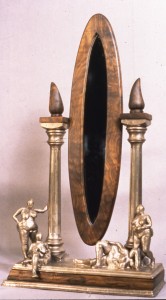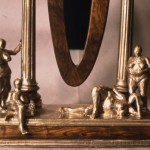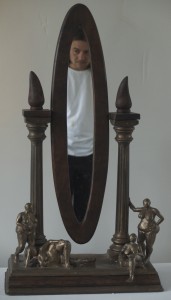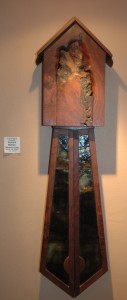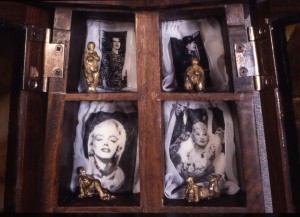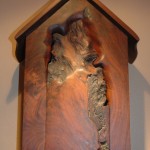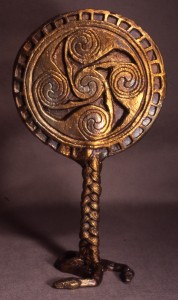Also Known as the Celtic Mirror, this piece was first shown in 1994 at the show I highlighted last week. Called “Age of Acceptance: Mirror Of Death/Mirror Of Life” It stands 15″ tall, weighs about 10 lbs. On one side, shown on the left, is a Celtic Design consisting of 5 triple spirals, or Triskelions. The mirrors “handle” is a braid, which turns into a base consisting of 3 snake heads. Lots of symbology here.
In her words from a later artist statement:
“My stories begin with the myth, the folk tale, the superstition and the stereotype hidden in our own homes. The familiar object with the obscure story attached, the piece we are aware of, but don’t notice, the inconsistency that some of us avoid… The relationship to women and the contradiction we live with daily…
…Similarly, the pot changes from a simple cooking implement, to a cauldron for unholy potions, our contrary roles of nurturer, healer, poisoner, witch…. The mirror becomes an object of vanity or magical sight. Mirrors gave me a gift of story about beauty, about vanity, a view of women as perhaps less intelligent, more fragile in their beauty that draws rescue, or repels it with the contradictions of intelligent and beauty… Woman as more susceptible to “evil”, or our powers to entice or attract “evil”, or be evil… Contradictions in the face of beauty… ”
Mirrors are a common magical tool. They can not only reflect the real world, they can be a window into the spiritual, the future, the invisible. For this purpose, it does not need to be a perfect reflective surface, so Rae did not polish the mirror surface to its potential. She had found pictures of old bronze mirrors from Greece and Rome.
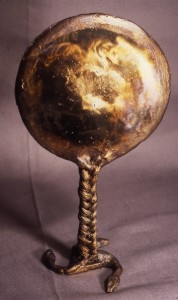
Celtic Mirror Front
The ‘face’ of the mirror is just reflective enough to give the impression of looking through a veil at a golden version of the room you are in, heavily distorted, and only coming into focus when you relax and look “through” it. It is too heavy to use as a hand mirror, but stands well, and is stable on its three snake-head ‘legs’.
The mirror top was made of a circle of wax in a plate, with the decorations made by cutting out of a thin slab of wax. Details and the spirals were cut in with clay tools. The handle was an actual braid of human hair, the snakes made by creating molds from Geltrate and plastic snakes, then pouring molten wax into the molds, and melding the wax to the hair, with a chopstick to give it rigidity to stand up long enough to place in the plaster and cast the bronze.
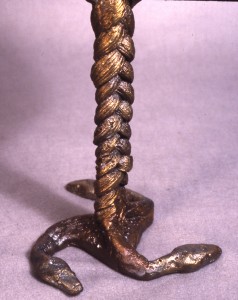
Handle and Base
The name came last. I am not positive about it’s exact meaning. Like much art, the artist creates, has a vision, and the viewer (consumer? audience? ) interacts with it, their own experience informing their interpretations. Literally, given the magical use of mirrors for scrying, the mirror of death could mean peering through the veil to communication with those who have left the world, miirror of life to view the present or future.
